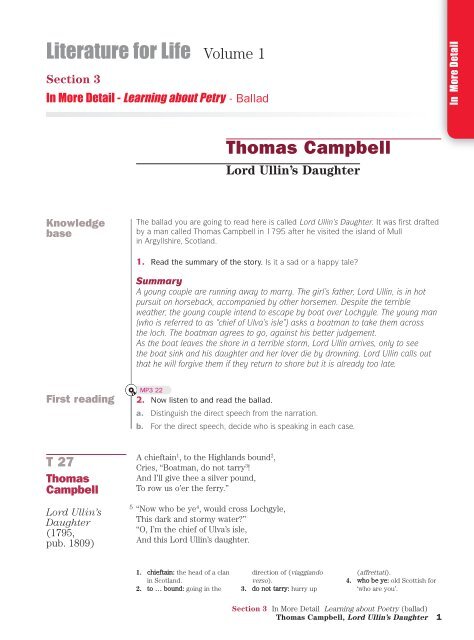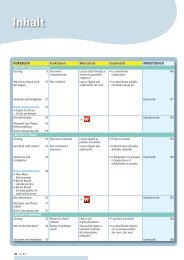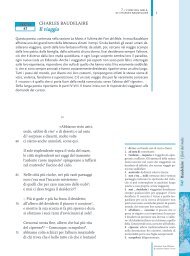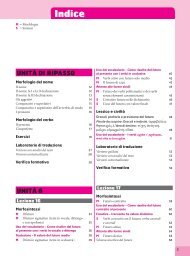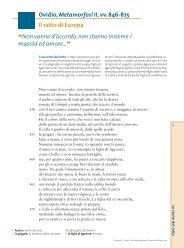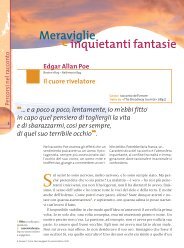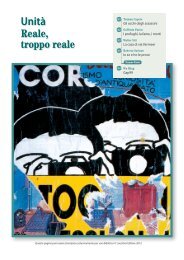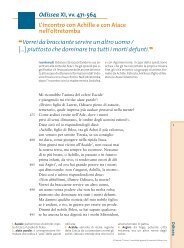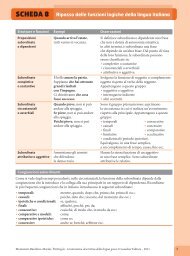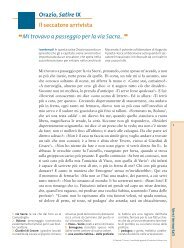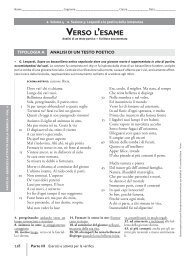Thomas Campbell, Lord Ullin's Daughter
Thomas Campbell, Lord Ullin's Daughter
Thomas Campbell, Lord Ullin's Daughter
You also want an ePaper? Increase the reach of your titles
YUMPU automatically turns print PDFs into web optimized ePapers that Google loves.
Literature for Life Volume 1<br />
Section 3<br />
In More Detail - Learning about Petry - Ballad<br />
In More Detail<br />
<strong>Thomas</strong> <strong>Campbell</strong><br />
<strong>Lord</strong> Ullin’s <strong>Daughter</strong><br />
Knowledge<br />
base<br />
The ballad you are going to read here is called <strong>Lord</strong> Ullin’s <strong>Daughter</strong>. It was first drafted<br />
by a man called <strong>Thomas</strong> <strong>Campbell</strong> in 1795 after he visited the island of Mull<br />
in Argyllshire, Scotland.<br />
1. Read the summary of the story. Is it a sad or a happy tale<br />
Summary<br />
A young couple are running away to marry. The girl’s father, <strong>Lord</strong> Ullin, is in hot<br />
pursuit on horseback, accompanied by other horsemen. Despite the terrible<br />
weather, the young couple intend to escape by boat over Lochgyle. The young man<br />
(who is referred to as “chief of Ulva’s isle”) asks a boatman to take them across<br />
the loch. The boatman agrees to go, against his better judgement.<br />
As the boat leaves the shore in a terrible storm, <strong>Lord</strong> Ullin arrives, only to see<br />
the boat sink and his daughter and her lover die by drowning. <strong>Lord</strong> Ullin calls out<br />
that he will forgive them if they return to shore but it is already too late.<br />
First reading<br />
MP3 22<br />
2. Now listen to and read the ballad.<br />
a. Distinguish the direct speech from the narration.<br />
b. For the direct speech, decide who is speaking in each case.<br />
T 27<br />
<strong>Thomas</strong><br />
<strong>Campbell</strong><br />
<strong>Lord</strong> Ullin’s<br />
<strong>Daughter</strong><br />
(1795,<br />
pub. 1809)<br />
5<br />
A chieftain 1 , to the Highlands bound 2 ,<br />
Cries, “Boatman, do not tarry 3 !<br />
And I’ll give thee a silver pound,<br />
To row us o’er the ferry.”<br />
“Now who be ye 4 , would cross Lochgyle,<br />
This dark and stormy water”<br />
“O, I’m the chief of Ulva’s isle,<br />
And this <strong>Lord</strong> Ullin’s daughter.<br />
1. chieftain: the head of a clan<br />
in Scotland.<br />
2. to … bound: going in the<br />
direction of (viaggiando<br />
verso).<br />
3. do not tarry: hurry up<br />
(affrettati).<br />
4. who be ye: old Scottish for<br />
‘who are you’.<br />
Section 3 In More Detail Learning about Poetry (ballad)<br />
<strong>Thomas</strong> <strong>Campbell</strong>, <strong>Lord</strong> Ullin’s <strong>Daughter</strong> 1
10<br />
15<br />
“And fast before her father’s men<br />
Three days we’ve fled 5 together,<br />
For should he find us in the glen 6 ,<br />
My blood would stain the heather 7 .<br />
“His horsemen hard behind us ride;<br />
Should they our steps discover,<br />
Then who will cheer my bonny bride 8<br />
When they have slain 9 her lover”<br />
In More Detail<br />
20<br />
Out spoke the hardy Highland wight 10 ,<br />
“I’ll go, my chief — I’m ready;<br />
It is not for your silver bright,<br />
But for your winsome 11 lady:<br />
25<br />
“And by my word! the bonny bird<br />
In danger shall not tarry;<br />
So though the waves are raging white,<br />
I’ll row you o’er the ferry.”<br />
By this the storm grew loud apace,<br />
The water-wraith was shrieking 12 ;<br />
And in the scowl 13 of heaven each face<br />
Grew dark as they were speaking.<br />
“Boatman, do not tarry!”, illustration for<br />
<strong>Lord</strong> Ullin’s <strong>Daughter</strong> by Herbert N. Rudeen<br />
(in Journeys Through Bookland, Vol. 6, by<br />
Charles H. Sylvester, Chicago, Bellows-Reeve<br />
Company Publishers, 1922).<br />
30<br />
35<br />
40<br />
But still as wilder blew the wind,<br />
And as the night grew drearer 14 ,<br />
Adown the glen rode armed men,<br />
Their trampling sounded nearer.<br />
“O haste thee 15 , haste!” the lady cries,<br />
“Though tempests round us gather;<br />
I’ll meet the raging of the skies,<br />
But not an angry father.”<br />
The boat had left a stormy land,<br />
A stormy sea before her, —<br />
When, O! too strong for human hand,<br />
The tempest gather’d o’er her 16 .<br />
And still they row’d 17 amidst the roar<br />
Of waters fast prevailing:<br />
<strong>Lord</strong> Ullin reach’d that fatal shore,<br />
His wrath was changed to wailing 18 .<br />
5. fled: escaped (siamo<br />
fuggiti).<br />
6. glen: Scottish for ‘valley’.<br />
7. heather: a moorland plant<br />
(erica).<br />
8. bonny bride: beautiful wife<br />
to be (bella sposa).<br />
9. slain: killed (ucciso).<br />
10. the hardy Highland wight:<br />
here it refers to the<br />
boatman (il tipo robusto<br />
delle Highlands).<br />
11. winsome: beautiful (bella).<br />
12. The water-wraith was<br />
shrieking: the demon of<br />
the loch was screaming<br />
(urlava il mostro delle<br />
acque).<br />
13. scowl: dark, angry face (il<br />
volto scuro e arrabbiato).<br />
14. drearer: darker (più<br />
scura).<br />
15. haste thee: hurry up<br />
(affrettati).<br />
16. gather’d o’er her: met<br />
above her (si accumulò<br />
sopra la barca).<br />
17. row’d: used the oars<br />
(remavano).<br />
18. His wrath was changed to<br />
wailing: his anger became<br />
crying (la sua rabbia<br />
diventò un lamento).<br />
Section 3 In More Detail Learning about Poetry (ballad)<br />
<strong>Thomas</strong> <strong>Campbell</strong>, <strong>Lord</strong> Ullin’s <strong>Daughter</strong> 2
45<br />
50<br />
For sore dismay’d 19 through storm and shade,<br />
His child he did discover: —<br />
One lovely hand she stretch’d for aid,<br />
And one was round her lover.<br />
“Come back! come back!” he cried in grief 20 ,<br />
“Across this stormy water:<br />
And I’ll forgive your Highland chief,<br />
My daughter! — O my daughter!<br />
In More Detail<br />
55<br />
’Twas vain 21 : the loud waves lash’d 22 the shore,<br />
Return or aid preventing;<br />
The waters wild went o’er his child,<br />
And he was left lamenting.<br />
19. sore dismay’d: very<br />
upset<br />
(profondamente<br />
sconvolto).<br />
20. grief: sadness and<br />
pain (dolore).<br />
21. ’Twas vain: it was<br />
of no use (non<br />
serviva a nulla).<br />
22. lash’d: beat<br />
(colpivano).<br />
In more detail<br />
Content<br />
Form<br />
and language<br />
3. Where in the ballad does it say the following Find the line references and answer<br />
the additional question.<br />
a. (lines ________ ) The young chief offers the boatman money. How much exactly<br />
b. (lines ________ ) The lovers have been on the run for days. How many days exactly<br />
c. (lines ________ ) <strong>Lord</strong> Ullin will take his revenge if he catches them. How will he take<br />
his revenge<br />
d. (lines ________ ) The boatman agrees to go but not for the money. What is the reason<br />
why the boatman agrees<br />
e. (lines ________ ) When they hear the sound of approaching horsemen, it is the girl<br />
who insists that they leave immediately. What does she say she<br />
cannot face<br />
f. (lines ________ ) When she realises the boat is going to sink, the girl appeals to her<br />
father. What does she say or do exactly<br />
4. Describe the form of the poem by making notes below:<br />
a. no. of stanzas: __________________________________________________________________________<br />
b. no. of lines per stanza: __________________________________________________________________________<br />
c. line length: __________________________________________________________________________<br />
d. end-stopping: __________________________________________________________________________<br />
5. Focus on language.<br />
Which of these words and phrases would you use to describe the language of the poem<br />
<br />
elaborate<br />
<br />
lyrical<br />
<br />
full of exclamations<br />
<br />
narrative<br />
<br />
vague<br />
<br />
ornate<br />
<br />
simple<br />
<br />
graphic<br />
<br />
dramatic<br />
Section 3 In More Detail Learning about Poetry (ballad)<br />
<strong>Thomas</strong> <strong>Campbell</strong>, <strong>Lord</strong> Ullin’s <strong>Daughter</strong> 3
Sound features<br />
6. Work out the poem’s rhyme scheme.<br />
7. Look at the main stresses in stanza 1.<br />
a. How many stresses are there in each line<br />
´ ´ ´ ´<br />
A chieftain, to the Highlands bound,<br />
´ ´ ´<br />
Cries, “Boatman, do not tarry!<br />
´ ´ ´ ´<br />
And I’ll give thee a silver pound<br />
´ ´ ´<br />
To row us o’er the ferry!” —<br />
b. Which of these statements is true The poem alternates …<br />
a. … lines of pentameter and tetrameter.<br />
b. … lines of tetrameter and trimeter.<br />
c. … lines of trimeter and dimeter.<br />
c. Can you identify the same stress pattern in other stanzas of the poem<br />
In More Detail<br />
Type<br />
repetition of phrases<br />
anaphor<br />
alliteration<br />
consonance<br />
assonance<br />
Standard forms<br />
8. Repetition is an important feature of this poem.<br />
a. Find an example of each type of repetition.<br />
Examples<br />
b. What is the effect of the repetition Tick the statements you agree with.<br />
a. It makes the poem more musical.<br />
b. It makes the words easier to remember.<br />
c. It highlights important words and phrases.<br />
d. It makes the poem boring and predictable.<br />
9. Here is a checklist of the main features of the standard form known as the<br />
traditional or folk ballad. Which features can you link to the ballad <strong>Lord</strong> Ullin’s <strong>Daughter</strong><br />
a. The authors of ballads are anonymous (usually minstrels and troubadours) and their<br />
narrators are impersonal.<br />
b. They were handed down orally and changed as they passed from person to person and<br />
from country to country. They were generally not written down until the 18th century.<br />
c. Ballads are meant for performance, with or without musical accompaniment, and so<br />
they contain many sound features, especially repetition, which make them musical<br />
and memorable.<br />
d. A key feature of ballads is their simplicity. The storyline is simple, often tragic, and<br />
focuses on action. There are no descriptive passages. The characters are<br />
straightforward and are not psychologically complex. The language is lexically and<br />
syntactically simple and contains stock phrases or formulae and codes which<br />
audiences immediately recognise.<br />
e. The traditional ballad stanza is a quatrain and usually alternates lines of tetrameter<br />
and trimeter (4-3-4-3 stress pattern). Different rhyme schemes are present but the<br />
most common are abab and abcb.<br />
f. Predominant themes of ballad stories are tragic ones of love, death, revenge,<br />
betrayal, conflict.<br />
Section 3 In More Detail Learning about Poetry (ballad)<br />
<strong>Thomas</strong> <strong>Campbell</strong>, <strong>Lord</strong> Ullin’s <strong>Daughter</strong> 4
BIOGRAPHY IN BRIEF<br />
Read the biography and find out how the text and the author’s life are linked.<br />
In More Detail<br />
<strong>Campbell</strong>, <strong>Thomas</strong> (1777-1844)<br />
<strong>Thomas</strong> <strong>Campbell</strong> was born in Glasgow, Scotland in<br />
1777. He was educated at Glasgow High School and the<br />
University of Glasgow where he won prizes for classics<br />
and for poetry. During the holidays he worked as a tutor<br />
in the western Highlands and his poem Glenara and the<br />
ballad of <strong>Lord</strong> Ullin’s <strong>Daughter</strong> were both written after a<br />
visit to Mull at that time. He became famous for his poem<br />
The Pleasures of Hope which dealt with popular issues<br />
of the time such as the French Revolution, the partition<br />
of Poland and slavery. He travelled in Germany<br />
before returning to Scotland and then settling in<br />
London. He continued writing and travelling<br />
and was then elected <strong>Lord</strong> Rector of<br />
Glasgow University in 1826. His family life<br />
suffered a series of sad events —<br />
<strong>Campbell</strong>’s wife died in 1828, one of his<br />
two sons died and the other became<br />
insane. <strong>Campbell</strong>’s health suffered, too,<br />
and he withdrew from public life.<br />
He died in 1844.<br />
Scottish School, Portrait of <strong>Thomas</strong> <strong>Campbell</strong>, 1815, engraving<br />
(Private Collection).<br />
Section 3 In More Detail Learning about Poetry (ballad)<br />
<strong>Thomas</strong> <strong>Campbell</strong>, <strong>Lord</strong> Ullin’s <strong>Daughter</strong> 5
SAY IT RIGHT<br />
<strong>Lord</strong> Ullin’s <strong>Daughter</strong><br />
NOTEBOOK<br />
Fill in the gaps in the texts by using the words provided.<br />
In More Detail<br />
<strong>Lord</strong> Ullin’s <strong>Daughter</strong> is a literary<br />
ballad, that is to say it is part of the<br />
couple<br />
forgive<br />
body of ballads that were not of the graphic<br />
Isle of Mull<br />
oral tradition, but which were (1)<br />
killed<br />
down in the 18th and 19th centuries.<br />
lamenting<br />
Its author is known to be <strong>Thomas</strong><br />
<strong>Campbell</strong> and it was inspired by a trip<br />
loch<br />
love<br />
<strong>Campbell</strong> made to the (2) in quatrains<br />
1795. The ballad was then revised and repetition<br />
sink<br />
finally published in 1809.<br />
storm<br />
Its tragic story tells of a young (3)<br />
three<br />
who are running away to marry in the<br />
Highlands. The girl’s father, <strong>Lord</strong> Ullin,<br />
trimeter<br />
written<br />
has been in pursuit of them for<br />
(4) days. The couple are sure that,<br />
if they are caught, the young chieftan will be<br />
(5) by the <strong>Lord</strong> and his men. Despite the<br />
terrible weather, the young couple ask a boatman<br />
to take them across the (6) . The boatman<br />
agrees to go, against his better judgement.<br />
As the boat leaves the shore in a terrible (7) ,<br />
<strong>Lord</strong> Ullin arrives, only to see the boat<br />
his daughter and her lover die by drowning.<br />
<strong>Lord</strong> Ullin calls out that he will<br />
them<br />
and<br />
if they return to shore but it is already too late.<br />
The poem has many typical aspects of the<br />
traditional ballad. It is in<br />
alternating lines of tetrameter and<br />
with<br />
and<br />
an abab rhyme scheme. It is regular and musical,<br />
the musicality being reinforced by (12) .<br />
Its language makes use of both narration and<br />
dialogue, it is simple,<br />
and dramatic and<br />
makes frequent use of exclamations to add to its<br />
drama. The story, which deals with the theme of<br />
(14)<br />
(13)<br />
(10)<br />
and death, has a very tragic ending in which<br />
we see the repentant father<br />
of his beloved daughter.<br />
(15)<br />
(9)<br />
(11)<br />
(8)<br />
the loss<br />
Section 3 In More Detail Learning about Poetry (ballad)<br />
<strong>Thomas</strong> <strong>Campbell</strong>, <strong>Lord</strong> Ullin’s <strong>Daughter</strong> 6


